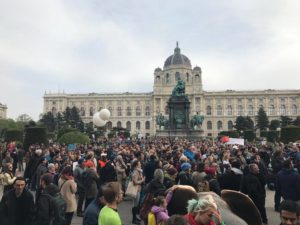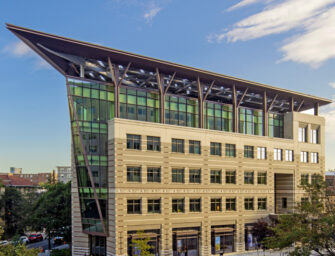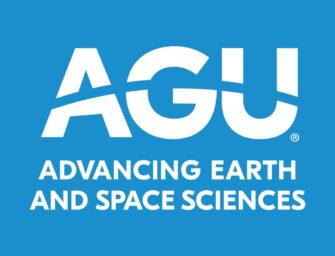March for Science: Reflections from AGU CEO and Executive Director Chris McEntee
Editor’s Note: This week, we’ll be sharing reflections on the March for Science from AGU leaders. This is part two of three. Click here for part one and part two.
While AGU President Eric Davidson and President-elect Robin Bell, the AGU team, members and scientists were assembling for a pre-March rally during the morning of 22 April, in Washington, D.C., the Vienna March for Science was well underway. Crowds were estimated at approximately 1700 and our group included both EGU and AGU members.
First and foremost, I’d like to give a big shout out to Angelo and Josh, from AGU’s Marketing and Strategic Communications teams, who made sure we had a place to meet and assemble, as well as a great bilingual banner and stickers, and to Oliver who organized the Vienna March. The AGU contingency was very warmly welcomed by all we met and marched with.
The March for Science in Vienna brought an international audience together, united in support for science, and yet, was uniquely Viennese at the same time. The event’s program included a trumpeter, a chorus, an organic chemist who used a composition by Mozart to illustrate the different personalities of his research lab, with different segments of the composition as examples of the personalities. The March itself wound through windy medieval streets starting in Sigmund Freud park and ending in front of the majestic Vienna Natural History Museum. EGU and AGU marched together behind our shared banner. It was a symbolic and outstanding show of cross-border unity and global collaboration, demonstrating the value that science brings value to all. Later, EGU hung the banner at the entrance to their meeting for all attendees to see.
Both EGU President Hans Thybo and I spoke to the gathered crowd and emphasized not only the strong collaboration between our organizations, but also how Earth and space science provides the entire planet with the knowledge and information that allow our communities to stay safe and to succeed economically.
While the feelings and fear of government intrusion in science seemed to be less acute than what I’ve seen and heard in the U.S., we’re seeing global recognition of the need to stand up for the key foundations of science – open flow of information, the rights of scientists, to use evidence-based science in decision-making at all levels of government, and to celebrate the value that science brings us.
One thing that I loved about participating in the Vienna march was seeing the tweets from AGU members around the globe who had either completed their march, were just getting underway or were just waking up to start their local marches. The March for Science was a truly international movement with large and small groups from both poles, across all continents, and in more than 600 cities large and small.
Editor’s Note:
- AGU has put together a five-week action plan with several easy ways you can speak up for science and keep the momentum from the March for Science going.
- Reach out and help build dialogue with your neighbors, community members, legislators, and others about science and its value by joining AGU’s Sharing Science Network
- Sign up for Science Policy Alerts or visit ScienceIsEssential.org for tips, tools and resources you can use to communicate the value of science.
- Watch this highlight video with footage from the March for Science nationally in D.C. and internationally in Vienna.






There are no comments
Add yours